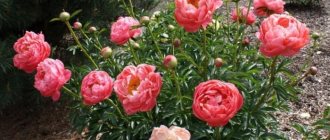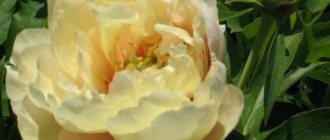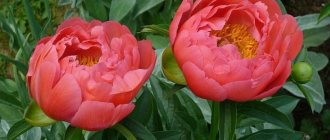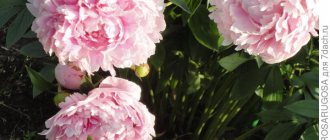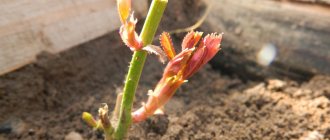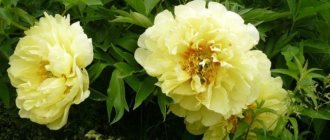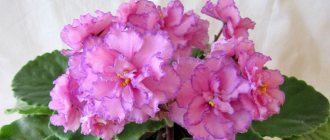Peony Coral Charm (Paeonia coral charm)
The history of the emergence of the Coral group of peonies is associated with the names of two scientists - Arthur Sanders and Sam Wissing.
If the first managed to obtain specimens with salmon and coral shades of inflorescences, then the second went further and created a whole group of such varieties, which included the Coral charm peony. The color of the petals changes from coral to milky
Attention! The group of coral peonies includes varieties not only with a coral tint of inflorescences, but also of other colors
Description of the plant
Peony Coral charm is a compact herbaceous plant 0.8-1.1 meters high. The shoots are well developed and erect. The leaves have a typical shape for peonies - trifoliate with veins. The color of the leaf blade is dark green, the surface is glossy.
The main attractiveness of the variety is the color and shape of the inflorescences. They are quite large - with a diameter of 16-21 cm. They are cup-shaped and semi-double in shape. The color of the petals as the bud opens changes from dark coral to light salmon.
On the eve of wilting, the petals may take on a milky hue and turn white around the edges. This was the reason for the appearance of the name “lacticiflora peony Coral charm”. The middle of the flower is filled with small yellow stamens. In June, active flowering begins and during this period the plant spreads a charming aroma.
This is interesting! In some Russian catalogs the plant is named incorrectly - you can find the following names: herbaceous peony Coral Charm or even peony Charm coral.
Advantages and disadvantages
The Coral Charm variety is almost perfect. It has a lot of advantages, which include:
- cold resistance;
- beauty and aroma of inflorescences;
- ease of reproduction;
- long and abundant flowering;
- good disease resistance;
- moderation in care.
The disadvantages include the following:
- demands on soil;
- need for regular feeding.
These factors can hardly be called disadvantages of this variety. All varietal peonies have similar qualities. In addition, proper preparation of the site and care of plantings will completely eliminate them.
Use in landscape design
Peonies are widely used in landscape design not only due to the beauty of the inflorescences, but also because they remain decorative until frost.
These perennials are often included in continuously flowering compositions and used to create low hedges and borders. It is good to plant peonies in the foreground in a rose garden - this allows you to extend the life of the decorative composition and decorate the bare shoots of tall varieties of roses.
Planting Coral Charm peonies as a decorative hedge
Diseases and pests
Herbaceous peony Coral Charm is very resistant to a number of diseases typical of flower crops. As a preventative measure, it is enough to spray with Bordeaux mixture in the spring.
Magic peony flower Coral charm
Unfortunately, pests attack peonies quite often, especially ants and aphids. Therefore, preventive spraying is necessary. If peonies are part of a multi-species flower arrangement, then spraying is carried out for all plants from its number.
Coral Charm is a beautiful and enchanting representative of the group of coral peonies. Its double flowers of an unusually delicate shade, combined with an exquisite aroma, make an unforgettable impression.
Growing this plant is not so difficult - it is enough to water it in a timely manner, apply fertilizing and carry out spraying for prevention. At the same time, the invested work will definitely be rewarded.
Growing a flower
To grow a healthy and beautiful plant, it is important to choose the right seedling. When purchasing planting material, you must carefully inspect it
Note! It is not recommended to buy a seedling with dried roots and signs of disease. It must have healthy and strong roots
Planting with root cuttings
Before planting a flower, you must first prepare the holes. The distance between them must be at least one meter. The depth of the seat should not be more than 5-6 cm.
The planting pit is prepared in advance, approximately three weeks before the planned planting.
Boarding time and seat selection
Experienced gardeners plant peonies in late summer - early autumn. Planting in spring is not recommended. Since peonies of this variety can grow in one place for about 10 years, the choice of site should be approached carefully and responsibly. Preference should be given to sunny and well-protected from the wind places. Also, water should not stagnate there. Flowers on the eastern side feel excellent.
How to prepare the soil and flower for planting
Experienced gardeners try to prepare the planting hole a month before planting the plant. Its diameter and depth must be at least 60 cm. As soon as the hole is ready, drainage and prepared soil mixture must be poured onto its bottom.
The soil must be fertile and not acidic. The following composition is considered the most optimal:
- one part peat;
- one part of humus;
- one part sand;
- one part clay.
Important! The top layer of soil should be no more than 25 cm
Preparing the soil for planting peony Coral Charm
Step by step landing procedure
When planting a peony, you must adhere to a certain algorithm. If the substrate has managed to settle over time, you need to add garden soil. In this case, you should not overdo it, since the buds located on top of the rhizome should be deepened from the surface of the soil by no more than 5 cm.
After deepening, the rhizome is sprinkled with soil, which is thoroughly compacted. The seedling is watered with water or a weak solution of manganese. One hole requires about 8 liters of water. The final stage is mulching the hole.
Peony Coral Charm in landscape design
Peony Sarah Bernhardt
According to the description, this variety of peony is a colorful pearl in the garden. The unique color of the flowers makes the bush a spectacular soloist in any garden composition. More often, the hybrid is planted on the lawn or against the background of a plain green hedge, emphasizing the special beauty of the plant. The coral hybrid also stands out in group plantings of peonies, surrounded by varieties with white flowers.
Growing a Coral Charm hybrid is a fun and easy task. A beautiful and fragrant bouquet will always be ready.
0 0 votes
Article rating
Care
For feeding, it is best to use a solution of mineral fertilizer with the addition of soap or washing powder (1 teaspoon per 10 liters). It is necessary to fertilize the plant by wetting the leaves from a watering can with a sieve. The procedure begins in the second week of May and is done once a month. Experienced gardeners recommend starting this work either in the evening or in cloudy weather to avoid direct sunlight.
Water the Coral Charm peony as the soil dries out. One adult bush consumes 2-3 buckets of water. This indicator should be monitored especially carefully during the period of budding and flowering. The plant also requires increased moisture at the time of bud formation; this process usually occurs in August-September. After watering, the soil must be loosened so that the water is evenly distributed throughout the root system.
The lifespan of hybrid varieties is limited to 7-10 years. In order for the peony to continue to exist, after this period it must be divided and transplanted to a new place.
To prepare the bush for winter, it is necessary to cut off all the stems at soil level. The resulting remains are sprinkled with ash. A young plant may also require additional shelter.
Peony Coral Charm, the photo of which can be seen above, is distinguished by its extraordinary beauty. If you care for it properly, it can live quite a long time and fill the garden with delicate shades and sweet aromas each new season.
Reproduction methods
The herbaceous peony Coral Charm is propagated in various ways:
- Seeds. It will take four years to wait for the seedlings to bloom, so the method is only relevant in specialized nurseries for growing a significant number of bushes.
- By layering. In the spring, the outermost stem is bent to the ground and sprinkled, insulated for the winter and planted at the end of the summer of the next season. Coral Charm will bloom in a year.
- By cuttings. They are cut from the middle part of the stems and placed in fertile soil; the rooting of the material is low and flowering will occur only in the fourth season after harvesting.
More details Milky-flowered herbaceous peony Coral Sunset (Coral Sunset)
All of the above methods are possible, but too time-consuming. On the site, gardeners propagate Coral Charm by dividing the rhizomes. The plant will be ready for transplantation and obtaining material after the phase of abundant flowering in the 4th–5th year of the growing season.
How to plant coral peonies?
Peony is a very beautiful plant. It is not surprising that many gardeners choose it. But in order for the culture to be pleasing to the eye, you need to know how to plant peonies. Experienced flower growers advise planting peonies in the ground in early autumn. Although in some cases you can do culture at the end of August. But still, experts recommend waiting until mid-September. This period is ideal in that the buds are fully formed.
How to plant peonies correctly is described below:
- Choosing a location. It is advisable that the site is on the sunny side and protected from the wind. For example, you can plant a plant near a bush or tree. The main thing in this case is to maintain a certain distance so that the roots grow and develop freely. It is also necessary to build a barrier from the wind. Peonies should not be planted close to home. After all, the walls radiate heat. Constant overheating is destructive for a flower. A space of 1.5-2 meters must be maintained between the building and the pit.
- Land preparation. She must be fertile. To improve the composition of the soil, nutrients should be added. Peony prefers loamy soil. But heavy clay ones are not suitable. But the situation can really be corrected by adding clay in combination with humus and peat. Peaty soils are not suitable.
- Fertilizer application. Before planting a young plant, a mixture consisting of ash, potassium sulfate and superphosphate is added to the hole. Water the top with a manganese solution.
- Planting and care. Make a small mound at the bottom of the hole. A division will be placed on it. The roots should be carefully straightened. Fill the voids with soil. It is required to plant so that there are several centimeters of soil above the top bud. After planting, irrigate and mulch. For mulching, use hilled soil with spruce branches or compost.
Knowing when to replant peonies and how to carry out this procedure correctly, there is every chance of growing a beautiful shrub that will delight you with abundant flowering. Without transplantation, a peony can grow for about 8-10 years. After which the bush is divided and transferred to a new place. They are usually replanted in the fall. But some gardeners are wondering whether such an event can be held in the spring. In principle, this is not prohibited
But it is important to remember that then such bushes will not bloom in the summer. And it will be much more difficult for the plant to withstand the heat.
Therefore, replanting peonies in spring is extremely rare.
Pests and diseases
The main infections to which peonies are susceptible do not pose a threat to the milky-flowering variety Coral Charm. With proper planting and timely care, the bush practically does not get sick. Powdery mildew is observed only in the shade and on waterlogged soil. The bush is replanted and treated with Fitosporin.
If the plant is in damp soil, the root-knot nematode parasitizes the seedlings. In this case, transplantation and use of Aktara is indicated. But the measures are effective only in case of minor damage; if the spread has reached a mass scale, the peony will die. The remedy is also effective against the bronze beetle.
Read more When and how to properly transplant peonies to a new place in the spring
Growing and planting in open ground
Most often, peonies are propagated by dividing the root system. You can use both its whole parts and sections - root cuttings.
Attention! A high survival rate of root cuttings of the Coral Charm peony was noted. In order to obtain new peony specimens, an adult plant is dug up and some of the soil is carefully removed from the roots.
After this, the rhizome is washed in water and left to dry for a day. When the roots dry out and become slightly soft, divide or cut the cuttings
In order to obtain new peony specimens, an adult plant is dug up and some of the soil is carefully removed from the roots. After this, the rhizome is washed in water and left to dry for a day. When the roots dry out and become slightly soft, divide or cut the cuttings.
Preparing for landing
Before planting plants in the ground, you need to prepare for it and think through everything. This implies several important points:
- Boarding time. Rhizomes can be planted in the ground both in spring and autumn. The most favorable period is the end of September.
- Accommodation. For peonies, you should choose a closed area with fertile soil. It is permissible to place the plants in a place that is illuminated in the first half of the day, and in the second half is in light partial shade.
- Soil preparation. On heavy or clayey soil, peonies grow poorly and sometimes refuse to bloom. To increase fertility and improve soil structure, it is necessary to add rotted dry manure and sand to the site. Before planting, apply a dose of complex mineral fertilizers.
- Preparing the plant. After removing the root system from the soil, it is washed and dried. Then you need to inspect the roots and trim off damaged and too long shoots. Before planting, it is recommended to soak part of the root system or cuttings cut from it in a solution of a growth stimulator.
Proper preparation for planting is half the success. When planting in the ground, you need to show no less diligence in order to enjoy fragrant flowers next summer.
Roots are used for propagation
Landing
After all the preparatory measures have been completed, you can begin planting peonies in open ground. The process itself is carried out step by step:
- Dig holes 1/3 larger than the root system.
- Pour a layer of drainage made of broken bricks, small pebbles or expanded clay.
- Pour a mound of soil, previously mixed with compost and sand in a ratio of 2/1/1.
- The rhizome is placed, distributing root shoots over the surface (if we are talking about cuttings, they are placed at the top of the mound).
- Gently water around the perimeter of the mound.
- Seal the planting hole with the remaining soil and compact the surface.
- Repeat watering and mulch the surface around the plantings.
When planted as part of the root system in the fall, already next year the flower will actively begin to grow. Before the onset of cold weather, they are watered several more times, and then covered with spruce branches for the winter. Although the Coral Charm peony is frost-resistant, young plantings need shelter.
Attention! In the first year of growth, the plant may produce several buds. It is better to remove them to stimulate the development of the root system and the growth of the vegetative mass of the flower
Propagation by seeds
Seed propagation of peonies is relevant only in one case - to obtain a new variety or intermediate results for selection. As a rule, flowers of different varieties are used and artificial cross-pollination is carried out.
Growing peonies from seeds is not so much difficult as it takes time. You can wait for such plants to bloom only for 5-6 years of life. That is why the method of dividing the roots is a priority.
Propagation seeds are used for selection purposes
Peculiarities
Regardless of the variety, all coral peonies have common characteristics:
- Large bush size. Most varieties grow up to 70–90 cm. The plants have a spreading crown and a well-branched root system.
- Frost resistance. These peonies feel great in the Russian climate and successfully winter when the thermometer drops to –40ºC.
- Moderate solarization and watering needs. Peonies grow well in open areas that get full sun most of the day. However, excessive solar activity can be detrimental to them. The soil in the flowerbed should always be moist. At the same time, stagnation of water or flooding of the area after the snow melts can provoke diseases of the root system.
- Drained neutral soil. Peonies do not like acidic soil. The maximum permissible pH level for normal growing season is 7.0 (recommended - 6.5). The soil should allow moisture to pass through and contain a small amount of clay. On heavy soils, peony roots develop poorly, which affects the size of the plant and the quality of flowering.
Information! To loosen the soil, dig up the flower bed with the addition of sand (1 bucket per 1 m²). The soil can be deoxidized by adding slaked lime (up to 500 g/m²).
Rules of care
Care comes down to watering and fertilizing, loosening the soil.
It is customary to feed peonies with mullein, pouring a liquid solution into circular furrows around the perimeter of the bush. Feeding of this type helps the roots develop quickly and successfully form buds for renewed growth, strong stems, and large leaves. If mullein is not available, it is replaced with mineral fertilizer dissolved in water.
Carry out regular, abundant watering twice a month, followed by loosening the soil around the bush. After flowering, it is advisable to feed the plant with phosphorus and potassium when watering.
For each adult plant you need to pour a couple of buckets of water, because you need it to reach the deepest roots
To prevent diseases, preventive spraying of the plant with chlorine copper oxide (40g per bucket) is carried out. It is enough to carry out the procedure once before and immediately after flowering. This will protect the bushes from spotting and gray rot.
After the first frost, when the leaves die, they are cut down to ground level. Earlier pruning interrupts the supply of nutrients to the storage roots.
Hybrid herbaceous coral peonies grow successfully in the Russian climate. If you follow the rules of agricultural technology, flowers will delight you with beauty, lush flowering, and an extraordinary richness of colors. Nurseries offer varieties of American selection, tested in conditions of cold, snowless winters and dry summers. For more than half a century, peonies with coral flowers have delighted all connoisseurs of beauty with their beauty.
Plant care
Lush flowering can only be achieved through proper care, which should be carried out regularly.
Watering and fertilizing
Peony Pink Hawaiian Coral
Caring for the milk-flowering peony Coral Charm must include weekly watering. After planting, during the first two years, fertilizers are not applied to the soil, since the flower receives everything it needs from the hole. After this period, fertilizing is systematically applied to the soil. This should be done three times a year:
- in early spring;
- during the period of bud setting;
- two weeks after flowering.
For fertilizing, first use wood ash, then a solution of mullein or bird droppings. Finish with the addition of superphosphate.
Note! When fertilizing with mineral fertilizers, you need to make sure that they do not get on the neck of the flower.
Mulching and loosening
Systematically loosen and mulch the soil near the paeonia Coral Charm bush. Especially such procedures must be carried out after watering.
Mulching paeonia Coral Charm
Preventative treatment
The herbaceous peony Coral Charm requires preventive treatments during the growing process. It is precisely such measures that help protect the flower from fungal diseases. To do this, in the spring the plant is sprayed with fungicides or Bordeaux mixture.
Peony Coral Charm (Paeonia Coral Charm) - what kind of variety is it
The Coral Charm peony flower captivates people and fully lives up to its name. The first hybrid with coral-colored petals was bred in 1964 thanks to the work of breeder S. Wissing.
How the milky-flowered peony Coral Charm blooms
For your information! The flower belongs to the group of semi-double perennials.
Brief description and characteristics
The main difference between the peony variety Coral Charm, as flower growers in Russia also call it, is its color. It can range from rich coral to baked milk. The flower is original and easy to care for. Grows well in temperate climates.
It stands out among all the others not only because of its unusual colors, but also because of its gigantic size. Peony Charm grows up to 120 cm in height.
The color of the bud changes depending on the stage of flowering. At first the plant is dark pink in color, in the middle of flowering it becomes soft coral with a light border, and at the end it acquires a pale pink hue.
Note! Of the entire coral series, this particular hybrid blooms later than all its relatives. The peduncles of this flower rise up to 95 cm
The leaves are medium-sized, dark green, few in number and tapering towards the top. The decorative effect of the bush remains throughout the entire season. Several large buds are formed on one peduncle, which reach 17-18 cm in diameter. Their structure is cup-shaped. The petals are semi-double to the touch, gathered in a thick center
The peduncles of this flower rise up to 95 cm. The leaves are medium-sized, dark green, not numerous and narrowed towards the top. The decorative effect of the bush remains throughout the entire season. Several large buds are formed on one peduncle, which reach 17-18 cm in diameter. Their structure is cup-shaped. The petals are semi-double to the touch and gather in a thick center.
Peony Coral Charm is a winter-hardy plant.
Herbaceous peony bud Coral Charm
Advantages and disadvantages of the variety
The main advantages of the flowers of this variety include an attractive appearance, a strong and tall stem, which allows you to not tie up the plant, as well as a decorative effect that lasts for a long time.
As for the shortcomings, this flower has practically none. The only thing that is noted is the late flowering.
Use in landscape design
There is a place for the magnificent and amazing Coral Charm peonies in absolutely any garden. Both single and group plantings look most impressive against the backdrop of a bright lawn. Ideal neighbors would be roses, clematis and phlox. Miniature mountain pines and junipers combine interestingly with peonies.
Peony Coral Charm in landscape design
History of appearance
This variety of lovely flower belongs to the coral series created by the American Sam Wissing in the 60s. In addition to our hero, this category also includes other interspecific hybrids: Coral Supreme, Coral Sunset. By the way, the overseas beauty can also be called Coral Charm. Its appearance is due to the merit of another scientist - Arthur Sanders, who at the beginning of the 20th century was the first to achieve the emergence of interspecific hybrids with such shades of petals as pink-orange, salmon and coral. And Wissing simply continued the work started by Sanders, receiving a gold medal for his achievement in 2002.
What do coral peonies look like?
Peony is a plant that belongs to the perennial class. It comes in different types: shrubby, semi-shrubby and herbaceous. The crop often has several stems. On average, the height does not exceed a meter.
Gardeners greeted the appearance of unusual coral-colored peonies with great enthusiasm, but it should be noted that coral color does not indicate a specific shade. For example, the buds of a plant may have a light orange-pink color or a darker tone. In the 60s of the twentieth century, a period of breeding varieties of coral-colored peonies began. The greatest results in this area were achieved by Canadian scientists Lyman Cousins and American Sam Wissing. They created Coral peony varieties, which later began to be in good demand among experienced and novice summer residents.
A detailed description of the Coral peony is given below:
- The root system is quite powerful.
- The leaves are trifoliate and pinnately divided. They are arranged in the following order. The color ranges from dark green to dark purple. It is extremely rare to find varieties with a bluish color. By autumn, the leaves acquire a yellow, reddish color.
- The diameter of the opened bud is from 15 to 25 centimeters. The flower has a multi-leaf, complex, star-shaped shape. The inflorescences are lush and beautiful.
- The seeds of the plant are quite large. Their shape is oval and round.
Reproduction and planting
Herbaceous interspecific hybrids, like all their counterparts, are propagated by cuttings or by dividing the bush. The most suitable is to divide the root with 2-5 buds, which, with proper care, throw out flower stalks in the second year.
Full flowering begins in the third season. For proper development of the bush, the rhizomes should not be too large. Many renewal buds will absorb nutrition from the tubers, preventing roots from developing.
Planting in open ground occurs in August and September. It takes 30 days for the cutting to root.
The correct choice of location for such a long-lived peony is of fundamental importance. He will have to settle on the site for 7-10 years. The plant does not like shade and damp areas with standing water. Otherwise, the herbaceous perennial is unpretentious.
The pit for planting is prepared in advance. Size 60-80 cm in diameter. Instead of the selected soil, a mixture of humus, peat, clay and garden soil is poured to approximately 2/3 of the height of the pit. The upper part, where the division will be located, is filled with ordinary soil. Planting material is buried 5-7 cm for light soils, and 3-4 cm for heavy, loamy soils.
Biological description
Perennial herbaceous plant.
Plant height is 91-120 cm. The bush is tall and durable. The leaves are narrow, dark green.
The flowers are about 18 cm in diameter, semi-double, cup-shaped, coral-pink, later coral-peach in color, the anthers are golden-yellow. The expression “coral coloring” does not indicate a strictly defined shade, just like “cherry” or “raspberry”. “Coral” is a mixture of bright pink and light orange tones in varying proportions.
The aroma is pleasant.
Mid-early flowering period. Blooms 5-7 days later than 'Coral Sunset'.
> In culture
Winter hardiness zones: 2-8.
For cultivation conditions, see: Peony lactiflora.
> Notes
Varietal characteristics of peony Coral
Hybrids, such as Charm, Sunset and others, reach a height of 90 - 120 cm. The stems are strong, without side buds. The leaves are narrowed, dark green in color. Semi-double flowers with a diameter of 16-18 cm. Peonies are winter-hardy, differ in flowering time and brightness of color. Suitable for growing in average climate zones.
The advantages include a tall, strong stem, which allows you not to tie up the bush and use the plant in single and group plantings.
Many well-known coral varieties develop well in the middle zone and are quite suitable for our climatic conditions
The middle and early flowering periods of hybrid varieties enable gardeners to supplement existing flower arrangements with new perennial shrubs.
Tall stemmed flowers are ideal for cutting and decoration.
Flowers should be cut from no more than 1/3 of the bush. Leaves and stems are vegetative mass, a source of nutrients for buds to renew growth. Their development ensures flowering in subsequent years.
Description of the variety
The herbaceous peony belongs to the group of semi-double perennial plants. This is a meter-long bush with long strong stems of a reddish hue, dark green carved foliage of a narrowed shape, often with a purple tint. The shoots of Coral charm are so thick, fleshy and strong that the appearance of large inflorescences does not contribute to their deformation. Each stem in early June is crowned with one to three large buds.
Coral charm blooms in early June. As the buds open, they gradually change their color: the dark salmon hue turns into a rich coral-peach tone, characteristic of the inflorescence in the phase of full dissolution. The flower shape is cup-shaped, diameter is from 17 to 20 cm. The middle is distinguished by bright yellow stamens. If you look at the amazing flowers from the side, they resemble a satin sphere. This effect occurs due to the fact that all the wide petals that make up the bud are bent towards the center. In addition, their edges are equipped with light stripes. During the long flowering period, the crop emits a soft floral aroma. The petals of the fading inflorescence lose their coral color, turning into tangerine yellow due to fading in the sun.
The variety has good drought resistance, high frost resistance (does not freeze when the air temperature drops to -40ºС), therefore it is suitable for cultivation in the middle climatic zone. Peony is not susceptible to disease and rarely becomes a victim of insect pests. Coral charm cannot be called capricious.
Agrotechnical features
To place a decorative bush on a site, you should choose an open place, flooded with diffused sunlight. The plant requires protection from drafts. The American hybrid Coral Charm prefers loamy, slightly acidic soil. Before planting, the soil is enriched with humus and superphosphate, after which the substrate is moistened and mulched.
You can water the peony up to three times a month. The plant also needs periodic weeding. The soil around the flower is regularly loosened. In autumn, all shoots on Coral charm are cut off, and the resulting stump is sprinkled with ash. In the first years of a flower’s life, preference is given to foliar feeding. Adult specimens are fertilized with a mineral complex three times per season.
Description
Peony is a perennial plant. All their types can be divided into several subspecies: these are herbaceous, semi-shrub and bush peonies. However, they all have a well-developed root system and dense stems, which can reach a height of up to one meter.
Peony leaves have a carved shape and a green color, which in some varieties changes over time. In some cases, you can also find bluish leaves. The flowers are most often double or semi-double and appear as large multi-colored buds. They reach 24 centimeters in diameter. The seeds of this plant are quite large, oblong or round in shape.
Description of the best varieties of coral peonies
For most flowers, unstable pigmentation is a drawback, but not for coral peonies. Under the influence of sunlight, their petals are able to change colors and play with shades. Some varieties manage to change color up to 3 times in one season.
In addition to excellent external data, coral varieties also have more practical features. Among them it is worth noting:
- long flowering;
- recognizable aroma;
- possibility of growing in different climatic zones;
- unpretentiousness.
Information! Coral peonies were born thanks to the work of American breeders L. Cousins, S. Wissing and A. Sanders. The main period of their work falls on the 60–80s of the twentieth century.
A miracle of selection - a description of coral varieties
The appearance of orange coloration was the result of extensive breeding work by the American chemist Arthur Sanders (1869-1953)
He began growing peonies in 1900 and became aware of the plant's vast genetic potential. Sanders's interspecific hybrids revealed new color shades, including coral, pink orange, salmon
Some types of peonies with a coral tint Coralie, Elizabeth Foster, Grace Ruth, Janice, Laura Magnusson, Natalie were created by a scientist in the mid-forties.
American breeders picked up the baton. The coral series was created by Sam Wissing Samuel and registered in 1964 and 1965. The famous Coral Charm (Paeonia Coral Charm), Coral Sunset (Coral Sunset) and Coral Supreme (Coral Supreme) are herbaceous interspecific hybrids. The breeder's achievement was awarded a gold medal for an outstanding variety in 2002.
Reproduction technique
Peonies can be propagated in several ways. Some of the most popular and effective are cuttings, dividing the bush and layering.
1To propagate a shrub by cuttings, you need to use a small piece of rhizome. Choose a stem that has at least one dormant bud. The cuttings are carefully separated from the mother bush and planted immediately in open ground. If you perform this procedure in July, the young plant will have time to take root in September. The main thing is to follow the planting rules, take care of fertilizing and watering. For the winter, the delicate plant needs to be well covered.
2To propagate a peony by division, the mother bush must be dug out of the ground. This should be done carefully, trying not to injure the root system. The plant is divided into several parts
It is important to ensure that good buds remain on each cutting. Afterwards the shrubs are planted in open ground
During the period of adaptation, they need special attention.
3For propagation by layering, you need to use adult bushes. Their shoots are pressed to the ground and covered with a layer of soil. The upper part of the stem should remain on the surface. The shoot is secured with a peg and, if necessary, additional soil is added. By September, the first roots appear on the shoot. The stem is carefully cut and replanted.
It is better to choose a dry day for peonies propagation.
After transplanting young plants, it is important to take care of abundant watering.
How to care for peonies?
Growing the Coral Charm peony is quite simple. The main thing is to comply with several conditions. Necessary:
- regularly loosen and mulch the soil;
- get rid of weeds in a timely manner;
- water the bushes abundantly and regularly;
- feed the soil with fertilizers;
- tie up bushes;
- remove faded buds in a timely manner;
- properly prepare plants for the onset of winter cold.
Loosen the soil around the bush with the utmost care
It is important to ensure that the root system of the plant is not damaged in the process. You need to go no more than 10 cm into the ground
It is better to carry out the procedure after watering or rain. In this case, an earthen crust does not form. Mulching allows you to retain moisture for a long time and prevent overheating of the roots in hot weather. You can use dry grass, sawdust, and fallen leaves for it.
The peony has a great need for regular hydration. Water is especially necessary at the beginning of the season, when the bush itself and the buds on it are actively growing. The plant needs to be watered once a week
It is important to ensure that at least 35 liters of water are spent on each bush. During hot periods, additional watering may be required.
How necessary it is can be judged by the dryness of the soil around the peony.
Large spreading bushes must be tied up. If this is not done, the heavy buds will eventually bend the bush to the ground. As a result, the central part of the plant will open, and the peony runs the risk of becoming waterlogged or, conversely, drying out. All this can lead to the death of a green pet. To prevent such a development of events, you need to carefully drive wooden pegs around the bush and tie the peonies to them with a rope.
To prepare the plant for the winter season, it is necessary to remove all branches at ground level. The remains of the stems are sprinkled with ash. If a young shrub will winter in open ground for the first time, it is recommended to take care of creating additional shelter.
Peonies after flowering
As soon as the peony fades, it begins a very important life period. At this time, the plant prepares for winter and restores its strength. Therefore, the further condition and development of the plant depends on how correctly the care is organized during this period of time.
Transfer
If you plan to transplant a peony, then, according to the descriptions of this variety, autumn is considered the most favorable period. The most important thing is to carefully prepare the soil and replant the flower correctly.

